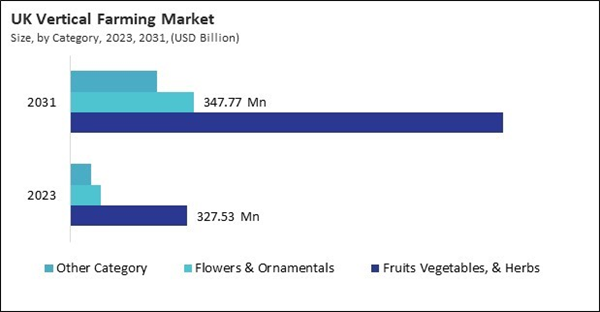The Europe Vertical Farming Market is expected to witness market growth of 19.4% CAGR during the forecast period (2024-2031).
The Germany market dominated the Europe Vertical Farming Market by country in 2023, and is expected to continue to be a dominant market till 2031; thereby, achieving a market value of $2.12 billion by 2031. The UK market is exhibiting a CAGR of 18.5% during 2024-2031. Additionally, the France market is expected to experience a CAGR of 20.4% during 2024-2031.
Vertical farms integrate seamlessly into the urban landscape as cities expand, utilizing rooftops, abandoned buildings, or purpose-built structures to bring food production closer to consumers. This reduces transportation costs and carbon emissions associated with traditional supply chains. Additionally, vertical farming has applications in regions with harsh climates - deserts or arctic zones - where conventional agriculture is impractical.
Moreover, vertical farms enable year-round production by creating self-contained ecosystems regardless of external weather conditions. The technology also extends to research and development. Universities, biotech firms, and agricultural startups use vertical farming systems as living laboratories to experiment with plant genetics, optimize growing techniques, and develop climate-resilient crops.
In Europe, agricultural land usage remains extensive, with 157 million hectares dedicated to farming, covering 38% of the EU’s total land area in 2020. However, most (63.8%) of agricultural holdings are small farms (less than 5 hectares), limiting large-scale agricultural production efficiency. The predominance of small farms presents challenges related to productivity, land fragmentation, and economic sustainability. Vertical farming offers an efficient alternative by enabling high-yield crop production in controlled environments, independent of land size constraints. As European policymakers focus on sustainable agriculture and food security, the adoption of vertical farming is expected to accelerate, particularly in urban areas with limited space.
The Germany market dominated the Europe Vertical Farming Market by country in 2023, and is expected to continue to be a dominant market till 2031; thereby, achieving a market value of $2.12 billion by 2031. The UK market is exhibiting a CAGR of 18.5% during 2024-2031. Additionally, the France market is expected to experience a CAGR of 20.4% during 2024-2031.
Vertical farms integrate seamlessly into the urban landscape as cities expand, utilizing rooftops, abandoned buildings, or purpose-built structures to bring food production closer to consumers. This reduces transportation costs and carbon emissions associated with traditional supply chains. Additionally, vertical farming has applications in regions with harsh climates - deserts or arctic zones - where conventional agriculture is impractical.
Moreover, vertical farms enable year-round production by creating self-contained ecosystems regardless of external weather conditions. The technology also extends to research and development. Universities, biotech firms, and agricultural startups use vertical farming systems as living laboratories to experiment with plant genetics, optimize growing techniques, and develop climate-resilient crops.
In Europe, agricultural land usage remains extensive, with 157 million hectares dedicated to farming, covering 38% of the EU’s total land area in 2020. However, most (63.8%) of agricultural holdings are small farms (less than 5 hectares), limiting large-scale agricultural production efficiency. The predominance of small farms presents challenges related to productivity, land fragmentation, and economic sustainability. Vertical farming offers an efficient alternative by enabling high-yield crop production in controlled environments, independent of land size constraints. As European policymakers focus on sustainable agriculture and food security, the adoption of vertical farming is expected to accelerate, particularly in urban areas with limited space.
List of Key Companies Profiled
- AeroFarms, LLC
- American Hydroponics
- BrightFarms, Inc. (Cox Enterprises Inc.)
- Plenty Foods Pty Ltd. (Josh Gadischke)
- Bowery Farming, Inc.
- Eden Green Technology
- Lindsay Corporation
- Hunter Industries, Inc.
- The Toro Company
- Valmont Industries, Inc.
Market Report Segmentation
By Component
- Hardware
- Lighting
- Hydroponic Components
- Climate Control & Sensors
- Software
- Services
By Category
- Fruits Vegetables, & Herbs
- Flowers & Ornamentals
- Other Category
By Mechanism
- Hydroponics
- Aeroponics
- Aquaponics
By Structure
- Shipping Container
- Building-based
By Country
- Germany
- UK
- France
- Russia
- Spain
- Italy
- Rest of Europe
Table of Contents
Chapter 1. Market Scope & Methodology
Chapter 2. Market at a Glance
Chapter 3. Market Overview
Chapter 4. Europe Vertical Farming Market by Component
Chapter 5. Europe Vertical Farming Market by Category
Chapter 6. Europe Vertical Farming Market by Mechanism
Chapter 7. Europe Vertical Farming Market by Structure
Chapter 8. Europe Vertical Farming Market by Country
Chapter 9. Company Profiles
Companies Mentioned
- AeroFarms, LLC
- American Hydroponics
- BrightFarms, Inc. (Cox Enterprises Inc.)
- Plenty Foods Pty Ltd. (Josh Gadischke)
- Bowery Farming, Inc.
- Eden Green Technology
- Lindsay Corporation
- Hunter Industries, Inc.
- The Toro Company
- Valmont Industries, Inc.
Methodology

LOADING...









